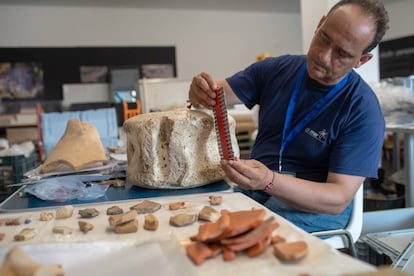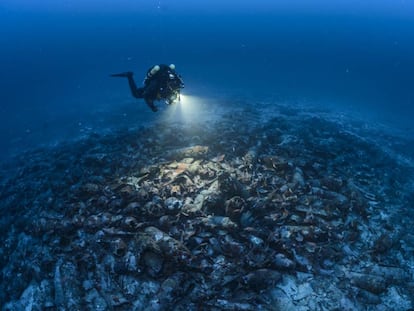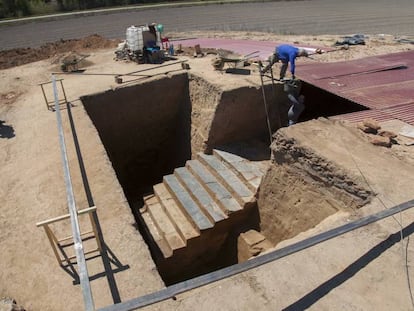Early Romans hunted whales 1,000 years earlier than first thought
The Spanish research team is now urging all historians and archeologists to re-examine their interpretation of history in the light of the revelations

The Romans didn’t just feast on red tuna and sardines or the red mullet that was used to make the famous garum fish sauce. Two thousands years ago, in ancient Rome, there was also a roaring trade in whale meat. Two species in particular were hunted – the North Atlantic right whale and the grey whale, a discovery that sheds new light on the culture of ancient Rome and the bygone habitats of the whales themselves.
Whales were mainly hunted for their bones
This is the conclusion an international team of ecologists, archeologists and geneticists have reached after four years of research published in the magazine Proceedings of the Royal Society of London B. After molecular analysis of ancient skeletal remains, the team has established that the whaling trade was thriving 1,000 years before it was previously thought.
“When you dig, you find as much of what you are looking for as what you are not,” says Darío Bernal Cassola, one of the seven co-authors of the study and coordinator of the archeological team at the University of Cadiz which came upon the largest number of bones in the Straits themselves.
The group was working at the Iulia Traducta archeological site in Algeciras when they found the first sample of what turned out to be the ancient remains of these whales. Shortly afterwards, the Baelo Claudia dig in Tarifa came up with more whale remains, reinforcing the suggestion that whaling was a tradition that went back several thousand years. “It enabled us to see that both sets of bones could not be one-offs. It was very exciting,” says Bernal who has spent the last 25 years researching Roman remains. The archeologists also focused on the sites of two Roman cities on the other side of the Straits – Septen Frates in what is now Ceuta and Tamuda, close to Tétouan.
When you are digging, you find as much of what you’re looking for as what you are not Researcher Darío Bernal Cassola
The four ancient Roman cities became well-known trading centers for the fishing industry, thanks to production of cured fish that was exported to the rest of the Roman Empire. All the sites, apart from Algeciras where the first bones were found, have thrown up further whale remains pertaining to various historical periods, which shows that it was not an isolated industry, according to Bernal.
In the curing factories and other locations where the whales were processed, the archeologists have located shrunken remains that suggest they were cooked for their fat and meat, though they were never as popular with the Romans as pigs for these purposes. Instead, it is thought they were primarily hunted for their bones, which were used to make objects such as tables for the fishermen or for cutting meat. In Tamuda, the dig even turned up a unique brush fashioned from whale bone.
Ahead of their time
But how were the Romans capable of hunting whales? “They did not have the technology necessary to catch the sperm whale or the rorqual whale that can now be found in the Mediterranean because they live far out to sea,” says Ana Rodrigues, a researcher for CNRS (National Center for Scientific Research in France) who was involved in the research.
The key was in the kind of whales they were hunting. New molecular technology applied by the geneticists allowed the archeologists to determine that the bones came from the North Atlantic right whale and the grey whale. These could be captured without all the technical advances of modern day whaling. The gray whale and its pups are wont to come so close to the coast, they can be seen from land and were likely to have been a temptation for the local fishermen, according to Rodrigues.
The research proposes that the early Roman whalers used small rowboats and harpoons, just as the first Basque whalers did in the 11th century when it is traditionally believed that the industry kicked off in Spain. Bernal has found evidence that in the Straits trade went into decline for 700 years, between the 2nd century BC and 500 AD, although that is not to say that the whaling stopped altogether.
The whaling trade was thriving 1,000 years before it was previously thought
Until now, there have only been isolated references to whales in early Roman literature; one concerning their medical properties and another on how to hunt them. No one ever guessed the ancient Romans had so much to do with whales, according to Bernal. It was not even known that the North Atlantic right whale and the grey whale had made the Mediterranean their home. And though it has not yet been possible to determine when these whales disappeared from the Mediterranean, Bernal has a hunch that the early Roman whaling industry was to blame.
After centuries of such persecution, the North Atlantic right whale is now struggling against extinction off the coast of North America. The other has disappeared from the Atlantic and is now confined to the North Pacific.
With the groundbreaking research, historical data, such as the description by naturalist Pliny the Elder written in the 1st century AD of killer whales attacking a whale and its newly born pup in the Bay of Cadiz, is now being looked at in a different light. “This fits perfectly with what we now know about the grey whale and the North Atlantic right whale,” says Anne Charpentier, a professor at Montpellier University who also worked on the project.
The research team is now urging all historians and archeologists to re-examine their interpretation of history in the light of the revelations. Bernal, who is involved in a new project at the Baelo Claudio site, is certainly intent on doing so. Meanwhile, co-author of the research Camilla Speller who is an archeologist and geneticist at the University of York, believes that geneticists will play a greater role in future research projects. “The new molecular tools open a window onto past ecosystems,” she says.
English version by Heather Galloway.
Tu suscripción se está usando en otro dispositivo
¿Quieres añadir otro usuario a tu suscripción?
Si continúas leyendo en este dispositivo, no se podrá leer en el otro.
FlechaTu suscripción se está usando en otro dispositivo y solo puedes acceder a EL PAÍS desde un dispositivo a la vez.
Si quieres compartir tu cuenta, cambia tu suscripción a la modalidad Premium, así podrás añadir otro usuario. Cada uno accederá con su propia cuenta de email, lo que os permitirá personalizar vuestra experiencia en EL PAÍS.
¿Tienes una suscripción de empresa? Accede aquí para contratar más cuentas.
En el caso de no saber quién está usando tu cuenta, te recomendamos cambiar tu contraseña aquí.
Si decides continuar compartiendo tu cuenta, este mensaje se mostrará en tu dispositivo y en el de la otra persona que está usando tu cuenta de forma indefinida, afectando a tu experiencia de lectura. Puedes consultar aquí los términos y condiciones de la suscripción digital.
More information
Archived In
Últimas noticias
Most viewed
- Reinhard Genzel, Nobel laureate in physics: ‘One-minute videos will never give you the truth’
- Oona Chaplin: ‘I told James Cameron that I was living in a treehouse and starting a permaculture project with a friend’
- Pablo Escobar’s hippos: A serious environmental problem, 40 years on
- Chevy Chase, the beloved comedian who was a monster off camera: ‘Not everyone hated him, just the people who’ve worked with him’
- Why we lost the habit of sleeping in two segments and how that changed our sense of time











































